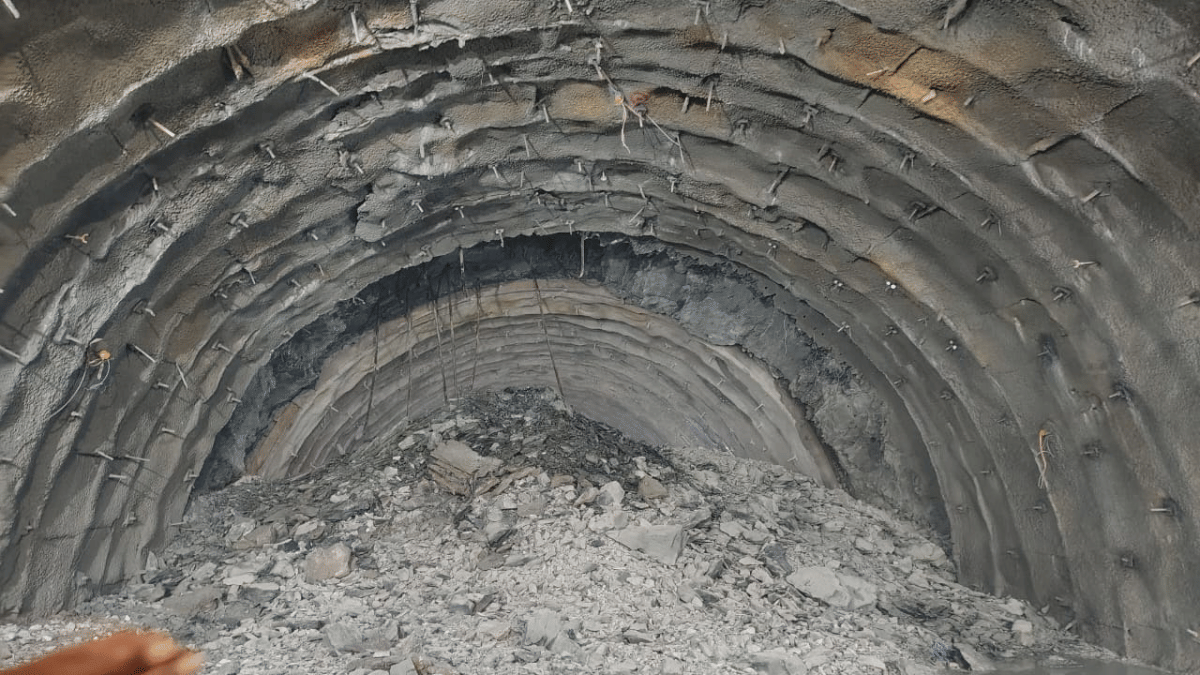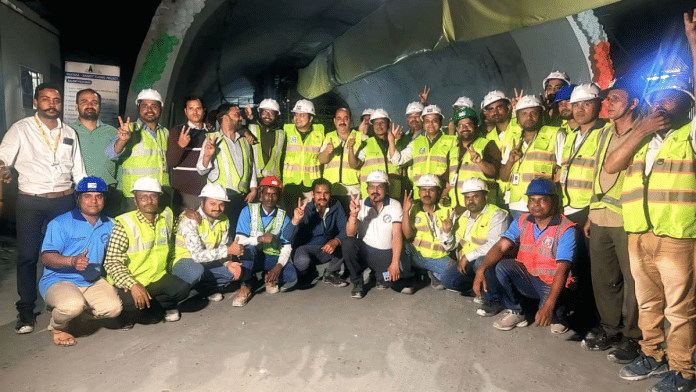New Delhi: “Last time I was inside this mountain, I didn’t know if I’d come out alive. Today, I’m part of the team that made the breakthrough (of the Silkyara tunnel),” says Akhilesh Kumar from Uttar Pradesh. “This is a moment of pride and peace.”
It was an emotional moment for some of the rescued workers from the 2023 tunnel collapse, who were present Wednesday when the breakthrough—when both ends of the tunnel meet—of the tunnel happened in Uttarakhand.
For Kumar and 40 other fellow workers, the 17 days spent trapped inside the collapsed tunnel cannot be erased out of memories completely. Afterall, they saw death at close quarters.
“I remember the sound of silence back then. It was terrifying,” says a worker from Assam. “Now, hearing the sound of the machine…it felt like the mountain exhaled. This time, we walked out by choice.”
To put it in his words, the worker says he came back to finish what he “started with fear but completed with strength.”
“This tunnel took something from me—sleep, peace, courage. I came back to take it back,” he says. “My daughter was born while I was trapped. I thought I’d never see her. Now, I’ll tell her I helped build this tunnel.”
In a way the Wednesday breakthrough is a happy chapter for this small group of brave men, who chose to return to the mountains, leaving aside the grim memories of the event that happened less than one and a half years ago.

NHIDCL general manager (projects-Silkyara-Barkot tunnel) Md. Shadab Imam tells ThePrint, “that with the major structural work completed, the tunnel is now entering its final phase.”
Officials say a trial run will be conducted in late 2025, followed by commissioning in early 2026, barring any unforeseen delays.
The tunnel project was conceptualised as part of the Char Dham Mahamarg Vikas Pariyojana, a flagship initiative launched by Prime Minister Narendra Modi to provide robust, all-weather road connectivity to the four shrines of Yamunotri, Gangotri, Kedarnath and Badrinath. The foundation stone for the tunnel was laid in 2018.
Being constructed under the supervision of the National Highways & Infrastructure Development Corporation Ltd (NHIDCL), the tunnel will reduce the distance between Silkyara and Barkot by approximately 26 km.
The existing route between Silkyara and Barkot currently winds through steep mountains and is particularly vulnerable to weather-induced disruptions.
ThePrint reached NHIDCL managing director Krishan Kumar and V.Umashankar, the Union road transport and highways secretary, over call and WhatsApp messages for his reaction over the Silkyara-Barkot breakthrough. This report will be updated as and when a response is received.
Also Read: Unwilling to return to ‘jaws of death’, rescued Silkyara workers turn farmers, grocers, shop owners
From survivors to builders
“I had to come back,” says Akhilesh. “People told me, ‘Why would you return to the place that almost killed you?’ But it didn’t feel right to leave it like that. I had to finish what we started.”
“It was not just a job,” he asserts. “It was unfinished business.”
Akhilesh is among a dozen workers who returned to the site after recovering from their trauma. Their return to the site wasn’t easy. Many of the workers experienced symptoms of post-traumatic stress disorder (PTSD)—sleepless nights, flashbacks, anxiety.
Jaydeb Das, who now operates heavy machinery inside the tunnel, echoes the sentiment. “When I entered the tunnel again for the first time after the rescue, I was shaking. But then I touched the wall and said to myself—this mountain tried to bury me, but I’m still here. I’ll finish this.”
“Coming back was a form of therapy,” concedes a worker from Bihar. “We had nightmares about this place.”
“When the wall fell and the light came through, I cried,” recalls Sovik, a worker from West Bengal. “We were once cut off from the world. Now, we’ve connected two towns (of Barkot and Silkyara).”
‘Much more cautious now’
Much was written about the New Austrian Tunneling Method (NATM), a flexible excavation technique suited to unstable rock, when the tunnel collapsed in November 2023. So, what’s the difference?
This time, officials say, safety has been paramount. “Every move is double-checked. Every layer of rock is monitored. We can’t afford another collapse—not structurally, not emotionally,” Shadab tells ThePrint.”
The major excavation and structural work is done, he says. “What’s left is the lining, flooring, and finishing.”
The next phase will involve critical installations, including safety and emergency systems. “We have to install major electromechanical systems, which are being imported from European countries. These include lighting, ventilation, and fire-safety mechanisms,” the top NHIDCL official says.
The high pressure water mist system (HPWMS) was used to deal with any possibility of a fire breakout inside the tunnel, he says. “HPWS offers fast fire suppression, smoke control and tunnel infrastructure protection. Its efficiency and adaptability make HPWMS ideal for modern tunnels prioritising life safety and operational continuity.”
The Silkayara tunnel, the top NHIDCL official says, was the first project wherein HPWMS was deployed.
“I am so happy that the tunnel is through the mountain,” Arnold Dix, president of the International Tunneling Association, tells ThePrint. “I’m excited that the pilgrim link will be finished. I was there just a few weeks ago.”
Regarding best practices for the post-breakthrough phase, particularly in terms of lining, ventilation, and fire safety, Dix says the lessons from the past must guide future action.
“The prior collapses tell us that all works must be undertaken with great care. It is still the same fragile mountain; it still demands great respect. This means carefully monitoring rock deformations and always being ready to adjust the response,” he says. “Like in the rescue, my same advice applies: be gentle and don’t go too fast.”
The bearded Australian, who became a familiar figure on television screens during the 2023 Silkyara tunnel rescue, says his bond with India has only grown stronger.
“The rescue was a miracle. I will come back each year to give thanks—thanks that all 41 men came out safe and with no injuries, and thanks that none of the rescue team got injured or killed. I’ll go back each year,” he adds.
Also Read: Rajas of rat mining, heroes of Himalayas have no insurance, safety gear or social dignity
Local deity
Modern technology isn’t the only force guiding the project, as faith is playing a part too. Near the tunnel’s entrance stands a temple dedicated to Baba Baukhnag, a local mountain deity. Many villagers and workers believe that disturbing the mountains without proper rituals had led to the 2023 collapse.
“After the accident, we knew we had to seek forgiveness,” said Devendra Rawat, a resident of Silkyara. “We requested the CM to make a temple here to show respect. Now every morning, the workers pray here before entering.”
At the breakthrough event, Uttarakhand Chief Minister Pushkar Singh Dhami made a mention of the local deity. “We all remember the unfortunate day of November 12, 2023, when the tunnel collapsed during the construction. … I had announced that a temple of Baba Baukhnag ji will be built, and today, we have conducted the pran pratishtha (consecration) of the temple,” Dhami said.
जय बाबा बौखनाग!
सिलक्यारा सुरंग के ऐतिहासिक ब्रेकथ्रू के अवसर पर आयोजित कार्यक्रम में सम्मिलित हुआ। इस अवसर पर टनल का निरीक्षण कर विशेषज्ञों और इंजीनियरों से टनल के बारे में जानकारी भी ली। इस टनल का ब्रेक थ्रू न केवल एक तकनीकी उपलब्धि है, बल्कि मानवीय संकल्प, सामूहिक परिश्रम का… pic.twitter.com/PpjS0NXwdu
— Pushkar Singh Dhami (@pushkardhami) April 16, 2025
The CM further proposed the Ministry of Road Transport and Highways (MoRTH) rename the tunnel after Baba Baukhnag.
“The temple wasn’t built out of fear. It was built out of respect. We now start our shift with a prayer—not just for us, but for the mountain to stay kind,” a worker from Bihar says.
For an Assam worker, the temple brings peace. “We don’t see it as superstition,” he asserts. “It’s respect for the mountains, for the lives lost in other accidents, and for the second chance we got.”
According to local residents of Silkyara and nearby villages, the tunnel is already bringing change in their lives. “Earlier, even a light rain would block the road for hours,” says Jagat Singh, a hotel owner in Barkot. “This tunnel will change everything—from tourist footfall to how quickly we get supplies.”
To the workers, the Silkyara tunnel is more than a passage. It’s a symbol of fear faced, of friends saved, and of lives rebuilt. “This tunnel is a scar and a medal at the same time,” Akhilesh says. “We’ll carry both.”
Some of the workers plan to stay till the last bolt is drilled. Others have already left the worksite after the breakthrough. But they are forever connected courtesy the mountains and the tunnel they helped complete.
“It’s not just a tunnel,” says a worker. “It’s a reminder—that even in the heart of the mountains, there’s hope.”
(Edited by Tony Rai)






